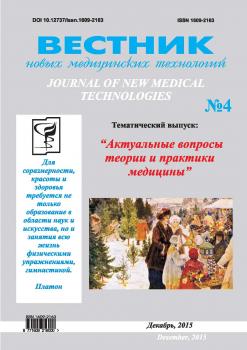Russian Federation
The comparative analysis of the dynamics of changes in the bioelectric activity of muscles in response to changes in static stress in the muscle is presented. As the main result of this study after an data analysis obtained by the methods of the chaos theory and self‐organization to describe complex biological systems, it was established low efficiency of deterministic‐stochastic approach. Shannon entropy calculation is performed in different functional states of the muscles. Analysis of the recorded signal and evaluation of randomness in the recorded signal of electro‐myograms showed that with increasing load the size of quasiattractors of the recorded bioelectric potentials of the muscles increases dramatically, but the results of the analysis based on the calculation of the entropy, i.e. the thermodynamic approach, are statistically insignificant. The results allow to conclude that deterministic‐stochastic methods (in particular, the thermodynamic methods) in the assessment of electro‐myograms have low efficiency, and should be used for calculating the area quasi‐attractors of S in evaluating the physiological state of the human body (its homeostasis).
muscle action potential, quasi‐attractor, the theory of chaos and self‐organization, the thermodynamic approach.
Ранее нами было установлено,
что использование новых методов в рамках тео‐
рии хаоса‐самоорганизации (ТХС) помогает вы‐
явить различия в ряде параметров, гомеостаза,
в частности биоэлектрических потенциалов мышц
(БПМ) [1‐5]. При различных исследованиях сей‐
час все более активно используется метод мно‐
гомерных фазовых пространств [4, 15‐19]. При
изучении и моделировании сложных биологи‐
ческих объектов существует возможность вне‐
дрения традиционных физических методов в
биологические исследования и новых методов
ТХС для сравнения их эффективности [6‐14]. В
этой связи в представленной работе демонстру‐
ется реализация такого подхода на основе ме‐
тода анализа двумерных фазовых пространств
при изучении особенностей реакции нервно‐
мышечной системы человека в ответ на дозиро‐
ванные статические нагрузки. Вместо традици‐
онного понимания стационарных режимов
биосистем в виде dx/dt=0, где x=x(t)=(x1,x2,…,xn)T
является вектором состояния системы (ВСС), в
этом случае используются параметры квазиат‐
ракторов (КА), внутри которых наблюдается
движение ВСС в фазовом пространстве состоя‐
ний (ФПС). Эти движения имеют хаотический
характер, т.е. всегда dx/dt≠0, но при этом дви‐
жение ВСС ограниченно в ФПС объёмом квази‐
аттрактора (КА) [1‐7, 17‐19]. Все это лежит в
основе новой ТХС [7‐14].





